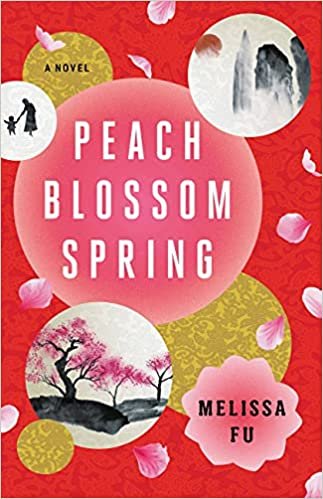Peach Blossom Spring by Melissa Fu
Review of Peach Blossom Spring by Melissa Fu
Peach Blossom Spring by Melissa Fu (2022). Published by Little, Brown and Company.
There are some books you just stumble upon right when you’re in the mood for a certain setting or theme. Recently, and when I say that, I mean the past few months, I think about how I’ve been slowly but surely getting back into my China studies groove.
I took ten years of Chinese classes, and only recently stopped when I am in graduate school. I’ve never really had the opportunity to travel to China, and because I left New York City, I don’t practice my putonghua as much as I should. Hence why I’m losing it, and I’ve been consuming a ton of Chinese dramas lately in an attempt to keep it up. All of those dramas I’ve been preparing to review, or have already, on this blog.
Books-wise though, I was wandering my local library’s new section when I stumbled upon Peach Blossom Spring in the F last name section. I saw the title, got curious, and read the synopsis.
Right then and there, I knew this was a story I was going to be interested in. Multigenerational tales can be hit or miss to me, but I still give them a chance. All in all, it took me four days to finish this book from cover to cover.
Here’s my review!
The story of one family across the World War II, the Chinese Revolution, and their immigration.
This is novel that takes place across multiple different timelines, but we begin in 1938. Melilin, a young woman, loses her husband when the Japanese begin invading mainland China, and with her young son, they’re forced to migrate to the interior parts of China. Her son, Renshu, is four, and she needs to make up stories with her scroll as they cross dangerous territories and terrain.
They settle in another city with his uncle and their daughters. His uncle is wealthy, as he plays up to the Kuomintang, or the Chinese government, which causes. major problems down the road when the Chinese Revolution begins.
However, Renshu and Meilin do what they can to survive, and the Japanese eventually make their way to the interior of China. Bombings become more commonplace, and they start to lose people they love in the horrific acts of violence. But when the war does end, a new beginning seems to be coming.
Relocated to Shanghai, Meilin and Renshu decide to do what they can to continue surviving. He goes to school, where he is smart, but behind the other city kids because of the war. Meilin picks up odd jobs until she finds something consistent, allowing them to keep going.
The peace is shattered quickly by the Chinese Revolution. Meilin makes big sacrifices to get Renshu and herself on a boat to Taiwan, where they have to start over again. Their family, connected to the Kuomintang, are missing, and things are going to look bleak for awhile.
Renshu continues studying hard, and eventually receives the opportunity to go to America to continue his education. He leaves behind his mother for the Midwest, where he will continue living there for the rest of his life, separated from his homeland, the shame and anger of surviving the war.
The story continues through his daughter, who does not understand why she is so disconnected from her heritage. This then shifts into a story about what we sacrifice in war, and how the world continues in ugly ways beyond its official end.
Overall Thoughts
I loved this novel overall! I think it shines the most in the World War II and Chinese Cultural Revolution periods, as it focuses on Meilin rather than David/Renshu. Renshu’s life in America feels rushed and less developed than those parts of the novel.
Even though the last arc in America was more difficult to get through, I did really enjoy this novel. It was so moving and horrifying in some parts—it reminded me the more human side of war. I watched Hidden Blade on the flight to Malaysia, and that was the more espionage side of the war in Shanghai.
Go read this one if you haven’t already. If you’re interested in it beforehand, I think you’re really going to like this one.
Follow me below on Instagram and Goodreads for more.


![Jeju-do (제주도) is one of those places that reminds you of how stunning the world is
[7.12.2024 부터 7.14.2024 까지]](https://images.squarespace-cdn.com/content/v1/5ea1f794501b7153b29e7cd7/1721033601522-554E76HR01JUHDWZBJ1I/image-asset.jpeg)









